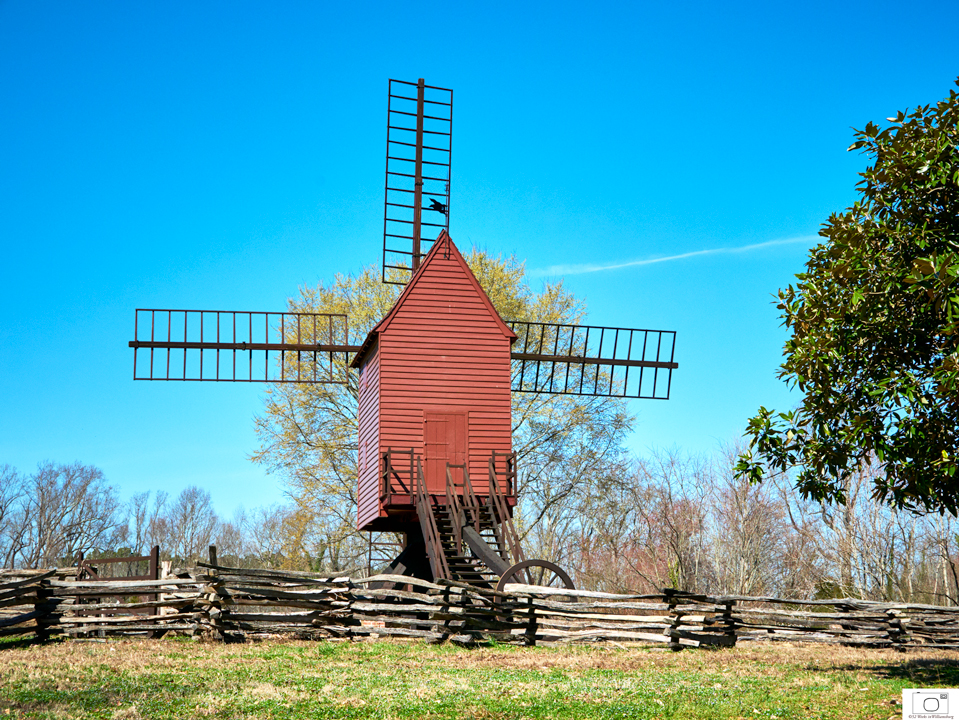An Historical Puzzle

Robertson’s Windmill – February, 2017
When I was taking pictures on the pedestrian bridge at the Visitor’s Center for How Are We Doing, it was a very sunny, brightly lit day. It was the perfect amount of light for taking images of brass plaques, as long as I remembered to keep my shadow out of the photos, but way too much light for shooting images that are more three dimensional and involve the sky. While I was focused on the plaques, I was very aware of the large, dark red windmill at the end of the bridge on the right. I had seen it many times before, but not this color and not in this place. In my mind, it belonged somewhere else. I knew I would return when the light was more golden, the shadows deeper, and the sky bluer, which gave me time to do a little research.
For those of us who have lived here or visited Colonial Williamsburg before 2010, Robertson’s Windmill was right behind Peyton Randolph’s property and was painted white. The story of how it originally ended up there, and why it was eventually moved follows.
For the 350th anniversary of Jamestown in 1957, Colonial Williamsburg wanted to enhance visitor experience by recreating a fairly large, working machine related to farming and commerce used in the 18th century. The question, however, was where to locate the machine once built. Authenticity was, and remains, important to Colonial Williamsburg.
Researchers knew that a windmill used for milling grain and corn was located somewhere on William Robertson’s property toward the end of the first quarter of 1700. Deeds showed that late in 1723, William Robertson sold his land and all the buildings on it, including a windmill, to John Holloway. Eight months later in 1724, John Holloway sold the property to John Randolph. Very general information about plots of land existed, but specific maps marking the windmill’s location did not. Further, during the 232-year period from 1723 to 1955, roads and other construction had come and gone, destroying any possibility of finding a windmill foundation. By process of elimination, and a great deal of sleuthing, a site was chosen as the best guess estimate. The recreated windmill was constructed on a slight rise just behind and north of the Randolph property.
By the mid-1990’s, trees had grown blocking the wind, and the windmill was in need of repair. It was closed to the public in 2003. During this time, Colonial Williamsburg was changing its focus from a general view of colonial life in a town, to a specific view of the revolutionary period from 1760 to the late 1770’s. Research could not confirm that the original Robertson Windmill still existed when Peyton Randolph remodeled his property during this 20-year span. What to do with this piece of the puzzle that no longer fits the re-imagined concept and yet was very popular – sell it, destroy it, or move it?
Great Hopes Plantation is an area very near the Visitor’s Center and is a demonstration of rural farm life in Virginia during the 18th century. Between 2010 and 2015 the Robertson Windmill was moved, repaired, and rebuilt near this area because its purpose could be directly tied to a middling planter’s farm production. The color of the windmill was changed from white to a color more consistent with one used in the 1800’s. It is now painted the same color as the Peyton Randolph property, providing some connection to its heritage. The picture above shows Robertson’s Windmill in its a new home.
This entry was posted in
Uncategorized.

One Comment
This is very interesting, Bob. I did not know the history behind the windmill or its current state. The photo is beautiful. I need to get out and about more!
RAR response
Whether it is someone’s favorite or an image that I like, I always learn something new before I post the picture. That is why I put dark grey on my resource words so that others can get even more information, as in podcast in the last line, really interesting stuff. Thanks for looking.